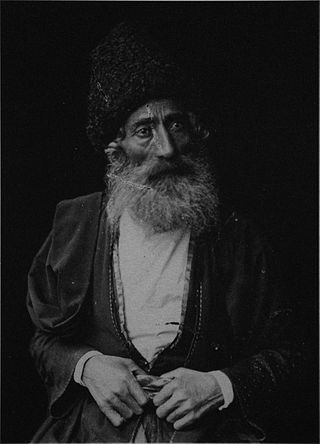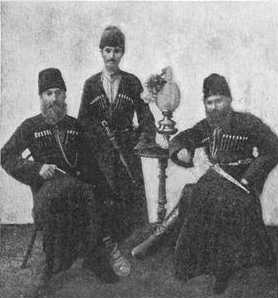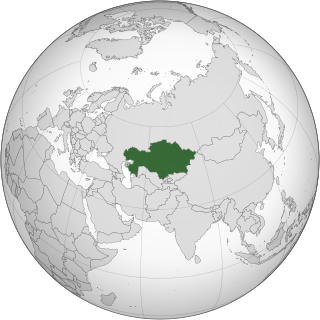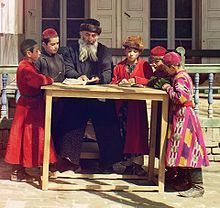
Uzbekistan, officially the Republic of Uzbekistan, is a doubly landlocked country located in Central Asia. It is surrounded by five countries: Kazakhstan to the north, Kyrgyzstan to the northeast, Tajikistan to the southeast, Afghanistan to the south, and Turkmenistan to the southwest, making it one of only two doubly landlocked countries on Earth, the other being Liechtenstein. Uzbekistan is part of the Turkic world, as well as a member of the Organization of Turkic States. Uzbek is the majority language, while Russian is widely spoken and understood. Islam is the predominant religion, and most Uzbeks are Sunni Muslims.

Demographic features of the population of Uzbekistan include population growth, population density, ethnicity, education level, health, economic status, religious affiliations, and other aspects of the population. The nationality of a person from Uzbekistan is Uzbekistani, while the ethnic Uzbek majority call themselves Uzbeks. Much of the data is estimated because the last census was carried out in Soviet times in 1989.

The history of the Jews in Russia and areas historically connected with it goes back at least 1,500 years. Jews in Russia have historically constituted a large religious and ethnic diaspora; the Russian Empire at one time hosted the largest population of Jews in the world. Within these territories, the primarily Ashkenazi Jewish communities of many different areas flourished and developed many of modern Judaism's most distinctive theological and cultural traditions, while also facing periods of antisemitic discriminatory policies and persecution, including violent pogroms. Some have described a "renaissance" in the Jewish community inside Russia since the beginning of the 21st century; however, the Russian Jewish population has experienced precipitous decline since the dissolution of the USSR which continues to this day, although it is still among the largest in Europe.

The Georgian Jews are a community of Jews who migrated to Georgia during the Babylonian captivity in the 6th century BCE. It is one of the oldest communities in the region. They are also widely distinguished from the Ashkenazi Jews in Georgia, who arrived following the Russian annexation of Georgia.

Fergana, or Ferghana, is a district-level city and the capital of Fergana Region in eastern Uzbekistan. Fergana is about 420 km east of Tashkent, about 75 km southwest of Andijan, and less than 20 km from the Kyrgyzstan border. Fergana is becoming one of the main tourist attractions with more night clubs and night life, being the border city to Kyrgyzstan the city attracts more foreigners to the city. The modern city was founded in 1876.

Bukharan Jews, in modern times called Bukharian Jews, are an ethnoreligious Jewish sub-group of Central Asia that historically spoke Bukharian, a Judeo-Tajik dialect of the Tajik language, in turn a variety of the Persian language. Their name comes from the former Central Asian Emirate of Bukhara, which once had a sizable Jewish population. Bukharan Jews comprise Persian-speaking Jewry along with the Jews of Iran, Afghanistan, and the Caucasus Mountains. Bukharan Jews are Mizrahi Jews, like Persian, Afghan and Mountain Jews.
Jews and Judaism in Tajikistan have a long and varied history. Many of the Tajik Jews were originally Bukharan Jews.

Bukhara Region is a region of Uzbekistan located in the southwest of the country. The Kyzyl Kum desert takes up a large portion of its territory. It borders Turkmenistan, Navoiy Region, Qashqadaryo Region, a small part of the Xorazm Region, and the Karakalpakstan Republic. It covers an area of 40,216 km2. The population is estimated at 1,976,823 (2022), with 63% living in rural areas.
British Jews are British citizens who are Jewish. The number of people who identified as Jews in the United Kingdom rose by just under 4% between 2001 and 2021.

FC Neftchi Fergana is an Uzbek football club based in Fergana. They play in the top division in Uzbekistani football and are multiple champions of Uzbekistan.

The history of the Jews in Azerbaijan dates back many centuries. Today, Jews in Azerbaijan mainly consist of three distinct groups: Mountain Jews, the most sizable and most ancient group; Ashkenazi Jews, who settled in the area during the late 19th-early 20th centuries, and during World War II; and Georgian Jews who settled mainly in Baku during the early part of the 20th century.

The history of the Jews in Kazakhstan connects back to the history of Bukharan and Juhuro Mountain Jews. Kazakh Jews have a long history. At present, there are approximately several thousand Jews in Kazakhstan.

The history of the Jews in the Czech lands, historically the Lands of the Bohemian Crown, including the modern Czech Republic, goes back many centuries. There is evidence that Jews have lived in Moravia and Bohemia since as early as the 10th century. Jewish communities flourished here specifically in the 16th and 17th centuries, and again in the late 19th and early 20th centuries. Local Jews were mostly murdered in the Holocaust, or exiled at various points. As of 2021, there were only about 2,300 Jews estimated to be living in the Czech Republic.

Shohimardon is a village and a subdivision of Fergana District, Fergana Region in eastern Uzbekistan. It is an exclave of Uzbekistan, surrounded by Kyrgyzstan, in a valley in the Pamir-Alay mountains. The name means ‘King of Men’ in Persian. The river Shohimardonsoy flows through the exclave. There are two villages: Shohimardon and Yordon.

Israel–Kazakhstan relations refers to the current and historical relations between Israel and Kazakhstan. The countries established diplomatic relations on April 10, 1992. The embassy of Israel in Astana, Kazakhstan opened in August 1992. The embassy of Kazakhstan in Tel Aviv, Israel opened in May 1996. In 2004, Chamber of Commerce and Industry Israel-Kazakhstan was established in Israel in order to develop and expand trade and economic relations.
The history of the Jews in Kyrgyzstan is linked directly to the history of the Bukharan Jews of Uzbekistan. Until the 20th century, most Jews living in the Kyrgyz areas were of the Bukharian Jewish community. However, during the 20th century, large amounts of European Jews began to emigrate to Kyrgyzstan which was then part of the Soviet Union, and a small amount of them still live in the country.
Armenians in Central Asian states: Uzbekistan, Kazakhstan, Kyrgyzstan, Tajikistan and Turkmenistan, were mainly settled there during the Soviet era for various reasons.
The history of the Jews in Central Asia dates back centuries, where Jews have lived in countries which include Kyrgyzstan, Kazakhstan, Tajikistan, Turkmenistan, and Uzbekistan.

Bukharan Jews in Israel, also known as the Bukharim, refers to immigrants and descendants of the immigrants of the Bukharan Jewish communities, who now reside within the state of Israel.
Fergana massacre happened in 1989, after riots broke out between the Meskhetian Turks exiled in Uzbekistan and the native Uzbeks. Hundreds of Meskhetian Turks were killed or injured, nearly 1,000 properties were destroyed and thousands of Meskhetian Turks fled into exile.















